Researching-the-Urban-Dilemma-Baseline-study
Researching-the-Urban-Dilemma-Baseline-study
Researching-the-Urban-Dilemma-Baseline-study
Create successful ePaper yourself
Turn your PDF publications into a flip-book with our unique Google optimized e-Paper software.
Europe and later North America. 217 The impacts of urbanization on new and old migrants were complex, and<br />
generated a host of impoverishment effects while also generating new opportunities. What distinguishes<br />
contemporary urbanization from historical trends is how urbanization is transpiring on a genuinely global scale<br />
involving most, if not all, developing countries. In 1950, just 30 per cent of <strong>the</strong> world´s population were<br />
considered urban dwellers but by 2050 this is expected to grow to over 70 per cent (see Figures 4a and 4b).<br />
What is new is how most of this growth is concentrated in less developed regions, with growth concentrated<br />
especially in Sub-Saharan Africa, Asia, and Latin America and <strong>the</strong> Caribbean.<br />
It is <strong>the</strong> pace of urbanization, toge<strong>the</strong>r with its sheer scale, that is likely to stress national and urban<br />
institutions in many developing countries to <strong>the</strong>ir breaking point. With few exceptions, <strong>the</strong> speed of<br />
urbanization is proceeding at a rate that exceeds <strong>the</strong> ability of city authorities and residents to respond. To put<br />
this in perspective, it took New York approximately 150 years to grow to 8 million people, while Mexico and<br />
Sao Paulo generated <strong>the</strong> same interval of population growth in less than 15 years. At <strong>the</strong> time of Pakistan’s<br />
independence in 1947, Karachi had a population of less than 500,000. By 2011, <strong>the</strong> metropolitan region<br />
included more than 18 million and generated almost three quarters of <strong>the</strong> entire country’s GDP. 218 In <strong>the</strong><br />
meantime, <strong>the</strong> number of cities with at least 1 million has increased more than fifteen-fold between 1950 and<br />
<strong>the</strong> present. Dhaka, Kinshasa, and Lagos today are each approximately forty times larger than <strong>the</strong>y were in<br />
1950. Taken toge<strong>the</strong>r, cities have absorbed nearly two-thirds of <strong>the</strong> global population explosion since 1950,<br />
and according to <strong>the</strong> United Nations Population Fund (UNFPA), are currently adding a million infants and<br />
migrants each week.<br />
Figure 4a: <strong>Urban</strong> population growth (thousands): 1950-2050<br />
7,000,000<br />
6,000,000<br />
5,000,000<br />
World<br />
More developed regions<br />
4,000,000<br />
Less developed regions<br />
3,000,000<br />
2,000,000<br />
1,000,000<br />
0<br />
1950 1960 1970 1980 1990 2000 2010 2020 2030 2040 2050<br />
Statistics compiled from http://esa.un.org/unpd/wup/index.htm<br />
Least developed<br />
countries<br />
Less developed regions,<br />
excluding least<br />
developed countries<br />
217 In 1800, for example, less than 10 per cent of <strong>the</strong> US population lived in communities with populations of more than 2,500 people.<br />
Today, more than 75 per cent of <strong>the</strong> population does so. Some analysts contend that structural adjustment programs (SAPs) supported<br />
by <strong>the</strong> World Bank and IMF during <strong>the</strong> 1970s and 1980s also hastened urbanization across Sub-Saharan Africa. Credit to IDRC – Nairobi<br />
for <strong>the</strong>se comments, January 2012.<br />
218 See Richardson and Bae (2005).<br />
40




